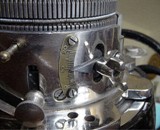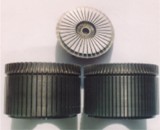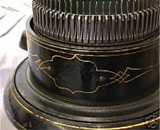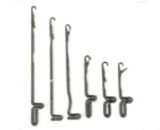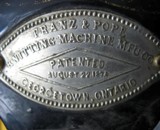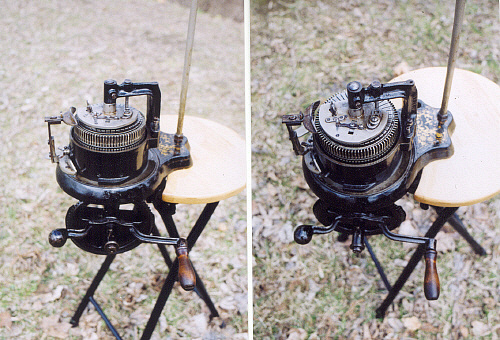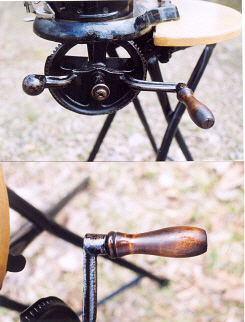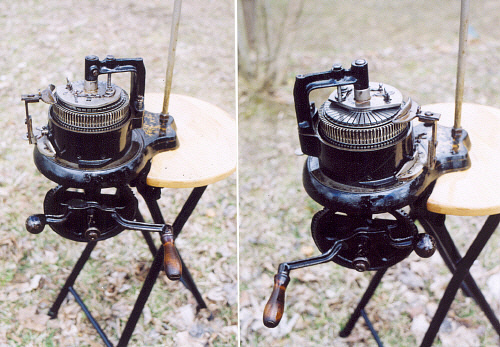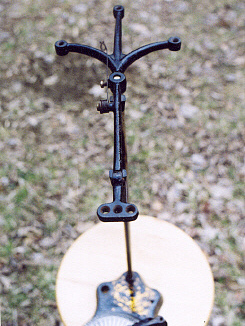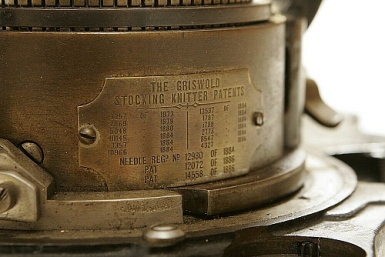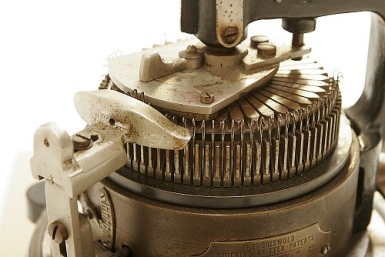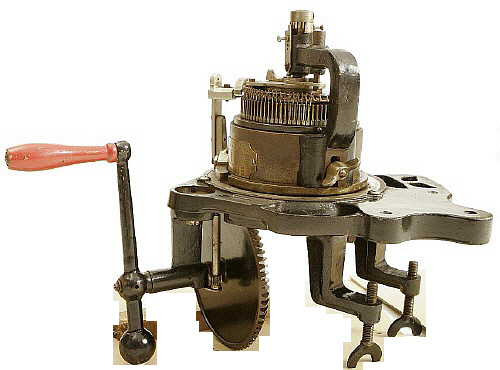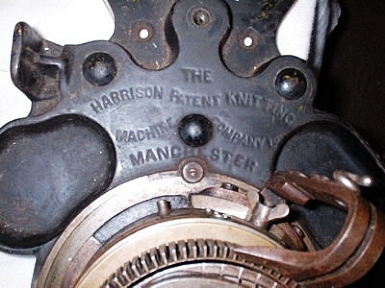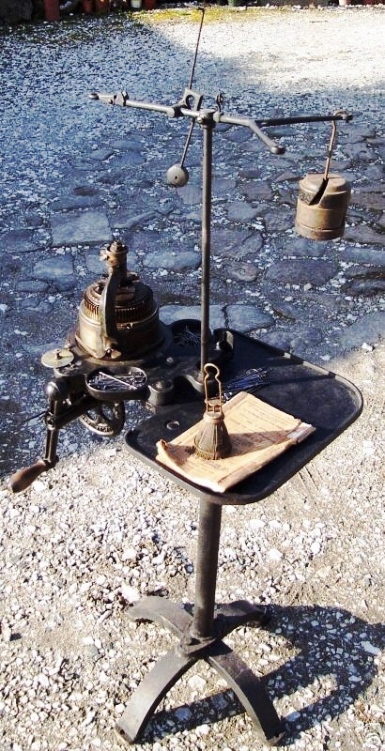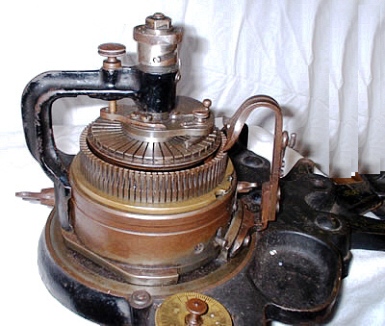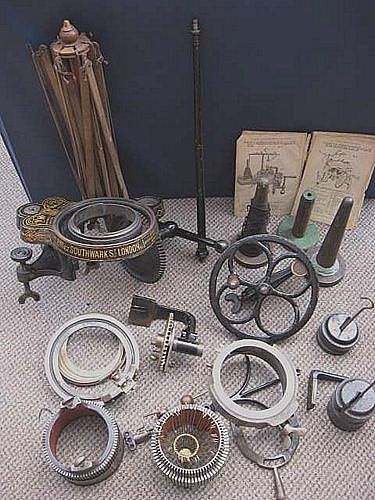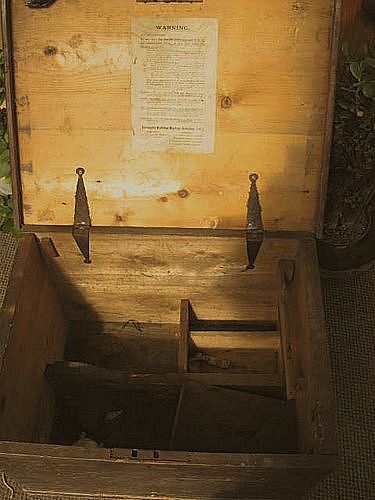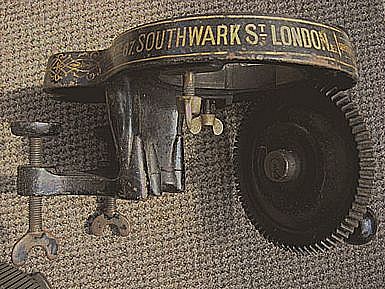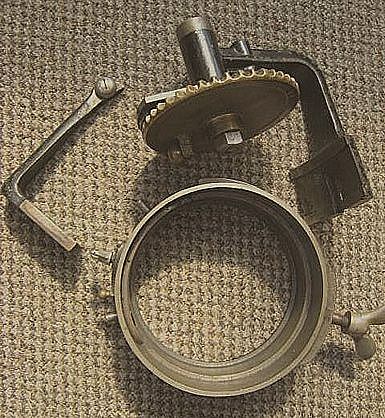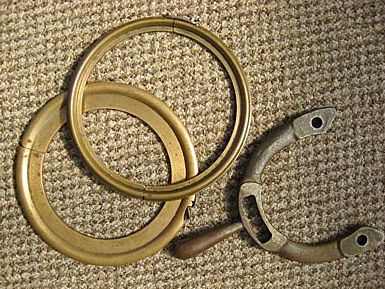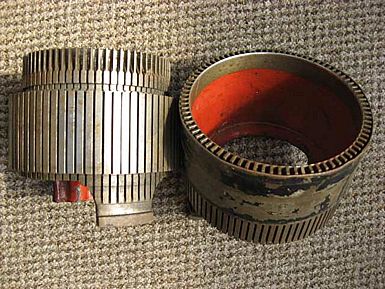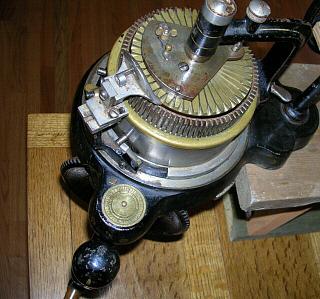Oldtymestockings English
Sock Machine Museum
|
|
|
|
Auto Knitter Knitting Machine
Made in Leicester, England, this
sock machine's outfit included a 30 slot ribber dial and 60
slot cylinder. Although quite similar to the Canadian and
American Auto Knitters, this English sock machine is
strikingly different. Cam shells and cylinder tension
mechanisms were made of of solid iron. Ribbers and
cylinders were composed of solid steel, not pot metal or
aluminum. Yarn carriers and tappet plates were styled after
the Creelman and Legare sock knitting machines. Note that
the large ribber arm pin is on the right (New Improved
Canadian Automatic Knitting Machines), not the left (Legares,
Creelmans and Canadian/American Auto Knitters).
|
|
|
|
Auto Knitter Knitting Machine -
Vintage
Manufactured in England from the earliest patents, this
English sock machine is one of the oldest in the series of
Auto Knitters. The rectangular shaped ribber arm,
beveled crank wheel, detachable needle holders, cloverleaf
base and yarn carrier are hallmarks of English engineering.
Note the shape and design of the accessories. Despite
the advancement of technology, few changes in their
construction were undertaken. The English Auto Knitter
was constructed of cast iron, steel and brass. It came
standard with 30/60 and 40/80 combinations. |
|
|
|
Cymbal Circular Knitting Machine
Manufactured in Newcastle Upon
Tyne, the Cymbal sock machine came complete with solid brass
accessories and 5 pounds of wool. A 42 slot ribber
dial and 84 slot cylinder accompanied each Cymbal knitting
machine.
|
|
|
|
Foster Star Nº2 Circular
Knitting Machine
The Star Nº2 circular knitting
machine was produced by
English inventor
James Foster of Friargate, Preston. This 4¼ sock
machine came standard with a 36 slot ribber dial and a 72
slot cylinder. |
|
|
|
Golden
Fleece Circular Knitting Machine
Manufactured in England, the
Golden Fleece sock machine closely resembles the Auto
Knitter sock machine in design. Parts and accessories of
Golden Fleece knitting machines were constructed of brass,
iron and chrome. A handy tabulator was built into the sock
machine to assist with row counting.
|
|
|
|
Griswold & Hainsworth Circular
Knitting Machine
Manufactured in England, this
English sock machine remains one of the oldest in existence.
Spindle shaped bobbins rotate around the cylinder whilst in
operation. Unlike the traditional horizontal
arrangement, the yarn mast stands vertical to the cylinder.
Adjustment of the ribber height is attained by untightening
a large thumb screw and lowering or raising the centre
ribber post. The unparalleled design of this English
sock machine originates from the British inventors,
Hainsworth and Griswold. |
|
|
|
Griswold Circular Knitting Machine
In England,
domestic circular knitting machines became known by the term
"Griswold", owing to Henry Josiah Griswold (1837 - 1929)
of Madison, Connecticut. In 1891, Griswold formed the
London and Leicester Hosiery Company and leased a factory on
Winifred Street in Leicester, England. Between 1890 and
1892, Griswold returned to America and sold his rights to
the firm to I. L. Berridge.
Numerous
improvements were introduced to Griswold sock machines.
Nevertheless, they remained solid. The most common setup
for Griswold sock machines was a 42 slot ribber dial and an
84 slot cylinder.
|
|
|
|
Harrison Circular Knitting Machine The
Harrison circular knitting machine was manufactured in
Manchester, England by the Harrison Patent Knitting Machine
Co. Ltd. Harrison knitting machines have the company's
emblem conspicuously stamped in their bases. A 42/84
setup came standard with each machine. Cast iron stands,
balling machines and large hand winders were available at
additional cost. At the turn of the century, the Harrison
circular knitting machine underwent a final improvement and
was termed the New Sun Circular Knitting Machine.
During their
age of manufacture, Harrison circular knitting machines
won 38 awards for superiority of construction and capacity
of work. The Harrison Patent Knitting Machine company was
the only English manufacturer of knitting machines to win 10
gold medals for craftsmanship in the knitting machine
industry. In 1908, the company was awarded the highly
acclaimed Grand Prix gold medal at the Franco-British
exhibition.
|
|
|
|
Harrison New Sunette Circular
Ribber Knitting Machine
The New Harrison Sunette
Circular Ribber sock machine was manufactured by the
Harrison Patent Knitting Machine Co. L. t. d. This
English sock machine was one of their earliest editions.
Note the sparse, golden decals along the base of the
machine; a sharp contrast to the Harrison Sun Circular
Ribbing machine. The New Sunette Circular Ribber sock
machine came standard with a 42/84 combination and an array
of knitting accessories. |
|
|
|
Harrison Sun Circular 3½ Knitting Machine
Harrison Sun Circular machines were manufactured in 3½, 3¾,
and 4 inch diameters for baby and infant stockings.
Harrison Sun Circular 3½ sock machines came standard with
36/72 or 42/84 combinations. Like Harrison's standard
4½ diameter Sun Circular Ribbing machines, the 3½ Sun
Circular Ribbing machines were composed of cast iron, steel
and brass. |
|
|
|
Harrison Sun Circular Ribbing Machine
The Harrison Sun Circular Sock
Machines were notable for the conspicuous golden decals along their bases and
ribber arms. In addition, the firm routinely engraved
their name into the base plates of their knitting machines.
Known the world over for outstanding engineering, the
Harrison Knitting Machine company produced a catalog of
circular and flat bed knitting machines for domestic and
commercial trade. |
|
|
|
Imperia Circular Knitting
Machine
Well known for its unique design, this English sock
machine displayed a solid brass counter that operated in
forward and reverse. Parts of this sock machine were
composed of solid chrome and iron. Alignment of the ribber
dial was accomplished by rotating a lever on the left side
of the sock machine which attached directly to the
cylinder. This lever enabled the ribber to rotate
backwards and forwards. The shape of the yarn mast
replicates the royal order in moderate fashion. Its 42 slot
ribber and 84 slot cylinder were popular for gentlemen's
trouser hose and ladies' saxony hosiery.
|
|
|
|
Imperia Circular Knitting Machine - Quadruplex
Imperia's
Quadruplex
sock machine included many of the ribber dial and cylinder
combinations produced by the company. Imperia's Quadruplex
model enabled the production of fine, saxony hosiery, as
well as conventional trouser socks. The Quadruplex
model was well-suited for commercial knitting or retail
trade. Ribber dial and cylinder outfits of 36/72, 42/84, 54/108 and
60/120 came standard with Imperia's Quadruplex model.
|
|
|
|
Imperia Circular Knitting Machine - Triplex
The Triplex
Imperia sock machine was commonly used to produce argyle
stockings, saxony hosiery and fine knitwear due to its high
slot counts. The Triplex Imperia sock machine featured ribber dial and cylinder outfits of 36/72, 42/84
and 54/108. The 42/84 combination is shown inside the
machine.
|
|
|
London Knitting Machine Company Duplex
Knitting Machine
Known for its |
|
|
Victoria Automatic Improved Knitting Machine
Manufactured by
W & J Foster, this English sock knitting machine is one of
their later versions. The Victoria
Automatic Knitting machines featured solid brass ribber
dials, brass counters, brass cylinder belts, brass wing nuts
and brass set up umbrellas. Their design approximates the
Griswold circular knitting machines. As with most English
circular knitting machines, a 42/84 set up was standard.
|
|
|
|
Victoria Automatic Knitting Machine
Manufactured by W & J Foster, this English sock knitting
machine is an early edition. Victoria Automatic
Knitting machines had the capability of accommodating duplex
cylinders. Note the two part yarn carrier.
Parallel screws allow proper alignment to various cylinder
sizes.
Duplex cylinders have diameters of 3¼, 3½ or 3¾ inches and
readily interchange with standard 4½ inch diameter cam
shells. In this fashion, ribbed, seamless socks for
babies and children could be knitted quite easily. Duplex
machines came standard with a 42/84, 4½ inch diameter
combination and a 36/72, 3¾ inch diameter combination.
|
|
|
|
Victoria Automatic Knitting Machine
The influence of regality
and sovereignty is readily demonstrated in the Victoria
Automatic Knitting machine. Manufactured in London,
England, the base of the Victoria sock machine replicates
the contour of the royal crown. Note the queen like quality
of the yarn mast. Solid brass ribber dials, cylinder belts
and row counters impart a majestic impression.
|
|
|
|
|
|
